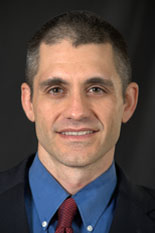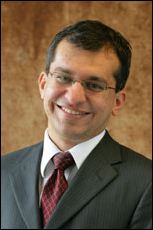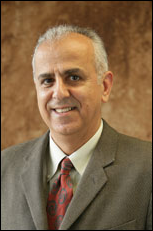News Story
Spotlight on NAVAIR-Funded Research at Maryland
A cooperative agreement between the University of Maryland (UMD) and the Naval Air Warfare Center – Aircraft Division (NAWC-AD) concerning the Research and Educational Development Program helps support a variety of research projects in the Department of Mechanical Engineering.
Through this research support, UMD faculty and students have the opportunity to support mission-critical work for the U.S. Navy.
Feature Design for Final Machining of Near Net Shape Parts in Additive Manufacturing
 Principal Investigator: Professor Hugh Bruck
Principal Investigator: Professor Hugh Bruck
Additive manufacturing (AM) processes such as direct metal laser sintering (DMLS) are being used to realize geometrically complex metal parts for a variety of aerospace applications. While the performance of these parts seem to be comparable to those manufactured in conventional processes, the use of DMLS potentially provides greater performance by tailoring the microstructure and properties of the sintered metal throughout the part. However, there are challenges in modeling and predicting the shape of part features due to thermomechanical residual stresses and potential defects that may result due to cracking and buckling.
The overall objective of this effort is to extend the processing-structure-property models we previously developed at UMD for pressureless sintering processes for Functionally Graded Materials (FGMs) to DMLS. This will help in developing strategies to control porosity, thermal stresses and optimize for mechanical properties. The desired feature shapes can then be obtained after finish machining using techniques such as electrical discharge machining (EDM). In addition, FGM components consisting of a bimodal distribution of fine and coarse particles of a single material or more than one can be potentially fabricated using DMLS. Designs using such FGM could result in a “core” and “skin” build-strategy in which the core density could be near 98% while the skin density near 100%. Progressively, FGMs could be tailored to achieve 50% - 98% density in different parts of the core with cellular construct and 100% in the skin providing weight savings and enabling feature shapes not possible otherwise.
Secure Estimation and Control for Resilient Networked Robotic Systems
 Principal Investigator: Professor Nikhil Chopra
Principal Investigator: Professor Nikhil Chopra
It is becoming increasingly evident that autonomous systems will be pervasive in the not so distant future and that they will play a significant part in our everyday lives. This will happen in areas such as transportation (autonomous cars), delivery (autonomous drones) and healthcare (autonomous surgical robots). Chopra’s project studies cybersecurity risks to autonomous and semiautonomous robotics systems. The primary focus of this project is on “man-in-the-middle attacks”—where an attacker or adversary may disrupt and change communication signals between networked robots or between a human operator and networked robots.
The research to date on this project has led to the development of a new physics-based approach for handling man-in-the-middle attacks in networked robotic systems. The algorithm, which has been developed in joint work with graduate students Yimeng Dong and Nirupam Gupta, provides a new perspective in understanding and mitigating security risks for networked robotic systems. Their work is a first step, in potentially developing a solid theoretical and technological foundation for security of networked cyber-physical systems.
Conformal 3-D Printed Carbon-Nanotube-Reinforced Composites
 Principal Investigator: Assistant Professor Siddhartha Das
Principal Investigator: Assistant Professor Siddhartha Das
Carbon fiber reinforced plastic (CFRP) composites are now starting to be used extensively in the aerospace industry because of their high stress-bearing capacity, favorable strength-to-weight ratio and ability to withstand high temperatures. Recently, carbon nanotubes (CNTs) have been used as the fibers in CFRP composites. These CNT-reinforced CFRPs have demonstrated superior properties to other CFRPs in terms of their mechanical and thermal stress bearing capacities, electrical conductivities, etc. They are now being used in medical and electronic applications, in addition to aerospace applications such as “nanostitching” of airplane skins and fabricating strong, lightweight and cost-effective airplane parts.
There are a number of challenges to manufacturing CNT-reinforced CFRP composites. These hurdles include composites that need to be: fabricated at one go; attain conformal shapes; and remain properly bonded to epoxy resin (forming the matrix) to ensure that they retain their shape even after the curing process.
Das’ research aims to develop novel 3-D printing techniques for additively manufacturing these CNT-reinforced CFRP composites through layer-by-layer direct write printing of epoxy resin and CNT meshes on flat and bi-directionally curved surfaces. Additionally, efforts will focus on mechanical and electrical characterization of these 3-D printed composites. Dr. William Frazier at NAVAIR is collaborating with Das on this research.
Risk-based Path Optimization for Unmanned Aerial Vehicles (UAVs)

 Principal Investigators: Professors Jeffrey W. Herrmann and Shapour Azarm
Principal Investigators: Professors Jeffrey W. Herrmann and Shapour Azarm
Operating unmanned aerial vehicles (UAVs) over inhabited areas requires mitigating the risk to people on the ground. Because the risk depends on factors like the flight path, UAV operators need approaches that can find low-risk flight paths between the mission’s starting and finishing points. UAV operators are concerned about the tradeoff between risk and flight time, because the flight paths with the lowest risk can be excessively long and indirect. Herrmann and Azarm have developed, tested and demonstrated a risk assessment technique and bi-objective optimization methods to find low-risk and time (flight path) solutions.
They have conducted computational experiments to evaluate the relative performance of the methods (their computation time and solution quality). The methods were a network optimization approach that constructed a graph for the problem and used that to generate initial solutions that were then improved by a local approach and a greedy approach and a fourth method that did not use the network solutions. The best approach improved the solutions generated by the network optimization step.
Now, they are working to develop a software architecture to integrate our approach with the U.S. Navy's Common Control System framework and to make the approach available on the Internet using a map-based browser interface.
Probabilistic Engine and Component Removal Forecasting
Principal Investigator: Professor Jeffrey W. Herrmann
To maintain the availability of naval aviation assets, forecasting the demand for maintenance activities (such as engine and component removals) is an essential input for financial budgeting and for planning human resources, facilities management and procurement. Inaccurate demand forecasts lead to wasted resources and low availability of assets. The U.S. Navy is currently using a variety of tools for this forecasting, but they want a more comprehensive and sophisticated modeling approach to create better forecasts.
Herrmann has created, through an iterative development process, a prototype discrete event simulation model that predicts the number of repairs per time period for a set of engines and aircraft usage over a specified time horizon. In his model, an engine moves through the following states: in service, waiting for repair, in repair, done with repair and spare. Generally, an engine will be in service until it fails, then it will wait to be repaired, undergo repair and then wait as a spare until needed.
The project is currently enhancing the simulation model to include engine components that need to be removed and replaced, groups of aircraft with different flight plans and other features that will increase the model’s usefulness to the Navy. NAVAIR reliability analysis experts are collaborating on the model’s development.
Human Performance Modeling and Virtual Reality Simulation for UAV Systems
 Principal Investigator: Assistant Professor Monifa Vaughn-Cooke
Principal Investigator: Assistant Professor Monifa Vaughn-Cooke
Human operators interacting with complex control systems face safety-critical risks associated with stress and cognitive load, which can compromise human and system performance outcomes. In unmanned aerial vehicles (UAVs), the operator must be constantly vigilant and take appropriate actions while interacting with data management and control systems such as visual imaging for approach and landing, advanced launch and recovery, and operations planning and information.
To establish a safe and effective interaction for hybrid system interaction (human-hardware-software), human performance principles must be taken into consideration in the design of critical components of the human system interface (HSI). Since field data collection in safety-critical domains is typically inflexible and limited due to the potential for operator distraction, simulating these environments to study human performance in a laboratory setting is ideal. The project’s proposed research will use UMD’s Hybrid-System Integration and Simulation Lab to create simulation environments that use empirical human performance modeling and simulation to determine the relationship between neurophysiological predictors of human performance for UAV operator performance.
The results of this research will inform HSI design to reduce the risks associated with cognitive load, and improve UAV operator human performance and system safety.
In addition to this research, the Department of Mechanical Engineering—in partnership with the Naval Air Warfare Center Aircraft Division (NAWCAD) and the College of Southern Maryland (CSM)—supports the Southern Maryland Mechanical Engineering Partnership Program. This program allows students to complete their basic engineering studies, along with general education in math and physics, at CSM before applying to a co-op program with NAWCAD, a division of Naval Air Systems Command (NAVAIR) at Patuxent River Naval Air Station and the Clark School of Engineering.
Published March 16, 2017









